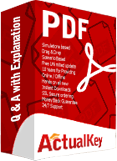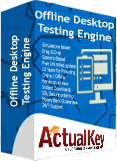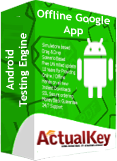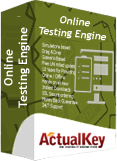Actualkey Prepration Latest Professional-Cloud-Database-Engineer : Google Professional-Cloud-Database-Engineer Exam Questions and Answers PDF's, Verified Answers via Experts - Pass Your Exam For Sure and instant Downloads - "Money Back Guarantee".
| Vendor | |
| Certification | Google Cloud Certified |
| Exam Code | Professional-Cloud-Database-Engineer |
| Title | Google Professional-Cloud-Database-Engineer Exam |
| No Of Questions | 132 |
| Last Updated | September 16,2024 |
| Product Type | Q & A with Explanation |
| Bundel Pack Included | PDF + Offline / Andriod Testing Engine and Simulator |




Google Cloud Platform GCP is Fastest growing Public cloud. Professional Cloud Database engineer certification is the one which help you to advance your career in Cloud Computing & learn about different offering by GCP in database.
Do you want to learn about the how to store terabyte to petabytes scale data in a structured or semi structured manner inside GCP environment .
You want to learn where YouTube & Gmail kind of billion user app store their data.
Do you want to learn about database which can handle billion of request in a second.
Do you want to learn about different Google cloud database product like cloud SQL, spanner, datastore, firestore, bigtable, alloydb.
If yes, You are at right place.
Cloud is the future and GCP is Fastest growing Public cloud.
87 percentage of Google Cloud certified individuals are more confident about their cloud skills.
More than 1 in 4 of Google Cloud certified individuals took on more responsibility or leadership roles at work.
Google Cloud Professional Database Engineer Certification is the best to invest time and energy to enhance your knowledge about GCP Database.
Professional Cloud Database Engineer
A Professional Cloud Database Engineer is a database professional with two years of Google Cloud experience and five years of overall database and IT experience. The Professional Cloud Database Engineer designs, creates, manages, and troubleshoots Google Cloud databases used by applications to store and retrieve data. The Professional Cloud Database Engineer should be comfortable translating business and technical requirements into scalable and cost-effective database solutions.
The Professional Cloud Database Engineer exam assesses your ability to:
Design scalable and highly available cloud database solutions
Manage a solution that can span multiple database solutions
Migrate data solutions
Deploy scalable and highly available databases in Google Cloud
About this certification exam
Length: 2 hours
Registration fee: $200 (plus tax where applicable)
Language: English
Exam format: 50-60 multiple choice and multiple select questions
Exam Delivery Method:
a. Take the online-proctored exam from a remote location.
b. Take the onsite-proctored exam at a testing center.
Prerequisites: None
Recommended experience: 5+ years of overall database and IT experience, including 2 years of hands-on experience working with Google Cloud database solutions
Exam overview
1. Get real world experience
Before attempting the Cloud Database Engineer exam, it's recommended that you have 2+ years of hands-on experience working with Google Cloud database solutions. Ready to start building? Explore the Google Cloud Free Tier for free usage (up to monthly limits) of select products.
Try Google Cloud Free Tier
2. Understand what’s on the exam
The exam guide contains a complete list of topics that may be included on the exam, helping you determine if your skills align with the exam.
3. Review the sample questions
Review the sample questions to familiarize yourself with the format of exam questions and example content that may be covered on the Cloud Database Engineer exam.
4. Round out your skills with training
Follow the learning path
Prepare for the exam by following the Cloud Database Engineer learning path. Explore online training, in-person classes, hands-on labs, and other resources from Google Cloud.
Additional resources
Your Google Cloud database options, explained
Database modernization solutions
Database migration solutions
In-depth discussions on the concepts and critical components of Google Cloud
Google Cloud documentation
Google Cloud solutions
5. Schedule an exam
Register and select whether to take the exam remotely or at a nearby testing center.
Review exam terms and conditions and data sharing policies.
QUESTION 1
You are developing a new application on a VM that is on your corporate network. The application will
use Java Database Connectivity (JDBC) to connect to Cloud SQL for PostgreSQL. Your Cloud SQL
instance is configured with IP address 192.168.3.48, and SSL is disabled. You want to ensure that your
application can access your database instance without requiring configuration changes to your
database. What should you do?
A. Define a connection string using your Google username and password to point to the external
(public) IP address of your Cloud SQL instance.
B. Define a connection string using a database username and password to point to the internal
(private) IP address of your Cloud SQL instance.
C. Define a connection string using Cloud SQL Auth proxy configured with a service account to point
to the internal (private) IP address of your Cloud SQL instance.
D. Define a connection string using Cloud SQL Auth proxy configured with a service account to point
to the external (public) IP address of your Cloud SQL instance.
Answer: C
QUESTION 2
Your digital-native business runs its database workloads on Cloud SQL. Your website must be globally
accessible 24. You need to prepare your Cloud SQL instance for high availability (HA). You want to
follow Google-recommended practices. What should you do? (Choose two.)
A. Set up manual backups.
B. Create a PostgreSQL database on-premises as the HA option.
C. Configure single zone availability for automated backups.
D. Enable point-in-time recovery.
E. Schedule automated backups.
Answer: B, D
QUESTION 3
Your company wants to move to Google Cloud. Your current data center is closing in six months.
You are running a large, highly transactional Oracle application footprint on VMWare.
You need to design a solution with minimal disruption to the current architecture and provide ease of migration to
Google Cloud. What should you do?
A. Migrate applications and Oracle databases to Google Cloud VMware Engine (VMware Engine).
B. Migrate applications and Oracle databases to Compute Engine.
C. Migrate applications to Cloud SQL.
D. Migrate applications and Oracle databases to Google Kubernetes Engine (GKE).
Answer: A
QUESTION 4
Your customer has a global chat application that uses a multi-regional Cloud Spanner instance.
The application has recently experienced degraded performance after a new version of the application
was launched. Your customer asked you for assistance. During initial troubleshooting, you observed
high read latency.
What should you do?
A. Use query parameters to speed up frequently executed queries.
B. Change the Cloud Spanner configuration from multi-region to single region.
C. Use SQL statements to analyze SPANNER_SYS.READ_STATS* tables.
D. Use SQL statements to analyze SPANNER_SYS.QUERY_STATS* tables.
Answer: B
QUESTION 5
Your company has PostgreSQL databases on-premises and on Amazon Web Services (AWS). You are
planning multiple database migrations to Cloud SQL in an effort to reduce costs and downtime. You
want to follow Google-recommended practices and use Google native data migration tools. You also
want to closely monitor the migrations as part of the cutover strategy. What should you do?
A. Use Database Migration Service to migrate all databases to Cloud SQL.
B. Use Database Migration Service for one-time migrations, and use third-party or partner tools for change data capture (CDC) style migrations.
C. Use data replication tools and CDC tools to enable migration.
D. Use a combination of Database Migration Service and partner tools to support the data migration strategy.
Answer: B
QUESTION 6
You are setting up a Bare Metal Solution environment. You need to update the operating system to
the latest version. You need to connect the Bare Metal Solution environment to the internet so you
can receive software updates. What should you do?
A. Setup a static external IP address in your VPC network.
B. Set up bring your own IP (BYOIP) in your VPC.
C. Set up a Cloud NAT gateway on the Compute Engine VM.
D. Set up Cloud NAT service.
Answer: C
Copyright © 2009 - 2025 Actualkey. All rights reserved.